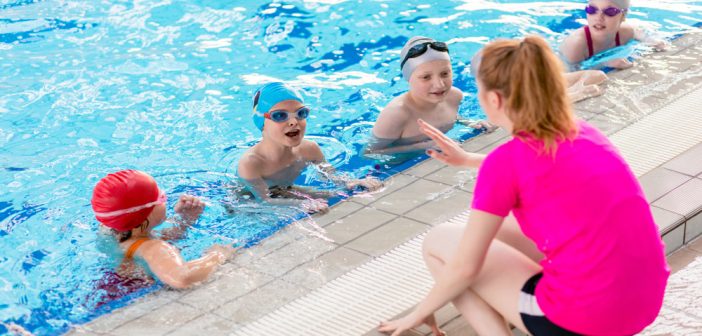Learning to swim is one of the mainstays of childhood. While it can be a fun and exciting, swimming lessons are also an essential part of children learning safety in the water. Good swimming lessons will carry them safely throughout their life in the countless hours they’ll spend in the water years ahead.
Parents signing their children up for swimming lessons should know that each level of swimming must be mastered before they progress. That means that children should only be signed up for the level of swimming they have proven to have mastery over the level before no matter what age they are.
The first lesson for all children is helping them get used to the water. Certainly, every swimmer should have a healthy respect for water and its safety requirements. However, it’s important that they first learn to be comfortable in water.
Learning to Float
One of the first most important lessons for any swimmer is learning to float. This requires a certain level of trust in the water that surrounds them. This usually starts in bath-time when a child learns to lie back in the water safely while supervised. As children age and they begin the lessons of flotation.
During the flotation learning period, parents should be assured that the child does not have a water build up problem in their ear. Get earplugs to avoid water build up while swimming. Without earplugs, children who get water buildup will often avoid floating or feel uncomfortable floating because water gets in their inner ear. This makes learning to float nearly impossible until this is addressed.
It’s important that children know that all people can float, they just need to learn how. Flotation works for people of all ages and weight levels.
Start Lessons Young
It is helpful to start a child in swim lessons young, but a child that is older should not be made to feel inferior for starting to learn to swim late. Learning to swim at any age is very important and should be celebrated. Children can take swim lessons before the age of 5 and some classes work with children as early as 1 year old. However the average age for swimming lessons is children 3-5 year old.
Most swim lesson classes run in 30-minute sessions over an 8- to 10-week period. Some are as short as 6 weeks. The longer the swim lesson program is, the better the child can properly master the level. Typically, children will learn one or two levels per year. When children are young, they usually master a single level throughout the summer.
Parents should know that swim lessons for any child under the age of five usually require the parent’s attendance and participation for the entire session. The importance of this cannot be understated since children start to build more confidence in the water when they are learning next to someone they know and trust.
Not All Swim Classes Are Equal
Parents should verify the skill level of the swim instructors to ensure they have the right credentials for teaching the skill level they are giving classes for. If they are new instructors, make sure they have oversight while they are teaching for the first few weeks. Because a person has a skill level to teach does not always mean they are capable of handling a group of swim student’s. Instructors should be certified in both CPT and First Aid.
Early swim lessons should always focus on learning to paddle and kick properly. This usually means using paddle boards. Parents can be supportive of these lessons by buying paddle boards for their kids and helping them use these during free swims. Since all basic levels of swim start with building proper arm and leg movement, early levels are an important time for them to master these skills.
Parental Supervision
It is recommended that parents should be at a child’s swim lessons until they are at a mastery level of swimming on their own beyond the age of 12. However, all pools have their own policies. Parents should learn the pools policies before they try to simply drop off a child at the pool. Many swim lessons can have free swims after lessons which some parents try to use for babysitting; this is unsafe and should be avoided.
Younger children often do not recognize or understand the dangers of deeper water. They can feel over confident in experimenting in the deeper water when their parents are not around, even if they are not ready to swim at that depth.
It should be noted that many pools have specific regulations about parental supervision. Lifeguards on duty are not meant to second as babysitters and parents should be aware that ultimately, they are the only ones that can ensure their child is properly attending to their swimming abilities.
Ensure the Pool Has the Right Temperature
Contrast of the temperature of the pool and air outside is an important consideration for swim lessons. Parents should check what temperature the pool is at the place they are expected to take lessons. Pool water should be kept between 84 and 88 degrees so children do not become too chilled during lessons. Colder waters in the 75-78-degree range can make children less likely to retain some of the information of their lessons if they are too focused on being cold.
The Use of Floaties
Floaties can be helpful in certain situations but not while a child is learning to swim. These devices can make a child feel over confident in the water which can lead to drowning if the child feels over confident near water and doesn’t realize the flotation device is the reason they are safe.









